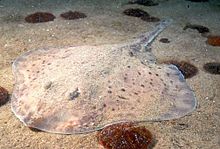
Little skate

The little skate (Leucoraja erinacea) is a species of skate in the family Rajidae, found from Nova Scotia to North Carolina on sand or gravel habitats. They are one of the dominant members of the demersal fish community in the northwestern Atlantic. This species is of minimal commercial importance and is mostly used as bait for lobster traps, though its wings are also marketed for food. It is also important as a model organism for biological and medical research. This skate is native to the western Atlantic Ocean, from Nova Scotia, Canada, to Cape Hatteras, North Carolina, USA. They are most abundant in the northern Mid-Atlantic Bight and the Georges Bank. Little skates prefer sandy or gravelly habitats from the shore to a depth of 90 meters (300 ft), though they have been caught as deep as 329 m (1,079 ft). They can tolerate temperatures of 1.2–21 °C (34.2–69.8 °F) and salinities of 27–33.8 ppt (though the optimum is 29–33 ppt). They do not undertake long migrations, but at the inshore parts of the species' range individuals move into shallower water during the summer and deeper water during the fall and winter. At the southern extent of the range, many also move north and south with changing temperatures. The little skate has a rounded pectoral fin disk 1.2 times as wide as long, and a blunt snout with a central tip. The jaws contain 38–66 series of round teeth on plates, adapted for grinding food. The pelvic fins are divided into two parts, with the forward lobe modified into a leg-like structure. The tail is longer than the disk in juveniles and shorter in adults. Two small, closely spaced dorsal fins are located near the tip of the tail. Adults have small dermal denticles and usually no midline thorns, though there are strong spines on the dorsal surfaces of the head, shoulders, and tail. Males tend to have fewer spines than females. The coloration of the little skate ranges from grayish to uniform or variable shades of brown above, becoming lighter towards the edges of the disk, and white or gray below. Most individuals have small, round, dark spots on the back. The tail has irregular dusky blotches or a dark gray ventral surface. The little skate may be confused with unspotted individuals of the winter skate (Leucoraja ocellata), which has a similar shape. This species typically measures 41–51 cm (16–20 in) long, but may reach 54 cm (21 in) long. Little skates grow to a larger maximum size in the northern part of their range. Little skates are more active at night and spend much of the day buried in sediment, usually near specific landscape features such as depressions excavated by other animals. They employ a curious mode of locomotion, dubbed 'punting' by the first scientists to document it, to move over the sea floor. The forward lobes of the pelvic fins are modified into leg-like structures called 'crura' (singular 'crus'), containing three flexible joints and modified skeletal and muscular elements. The little skate pushes off the substrate with both crura and then glides a short distance on its wings while repositioning the crura for the next push. The crura are also used as pivots when the skate needs to turn. Research proposes that the locomotion is akin to that found in land vertebrates and thus puts the evolution of the underlying genes 20 million years earlier. It has been speculated that using the pelvic fins in this manner assists in hunting, by reducing water turbulence that might alert the prey or distort the ray's electroreception. The tail of the little skate contains an electric organ that intermittently generates a weak electric field (the electric organ discharge or EOD). The EOD lasts 70 ms and has a head-negative monophasic waveform. This electric organ is thought to function in communication, and may help potential mates locate one another. Young and adult little skates are preyed upon by sharks, other skates, teleost fishes (including cod, goosefish, sea ravens, longhorn sculpins, bluefish, and summer flounder), gray seals, androck crabs (Cancer irroratus). Their egg-cases are preyed on by the sea urchin Strongylocentrotus droebachiensis and the whelk Buccinum undatum. Known parasites of the little skate include the protozoans Caliperia brevipes, Haemogregarina delagei, and Trypanosoma rajae, the myxosporeans Chloromyxum leydigi and Leptotheca agilis, the nematode Pseudanisakis tricupola, and the copepods Eudactylina corrugata and Lernaeopodina longimana. The diet of the little skate consists mostly of decapod crustaceans and amphipods. Polychaete worms are also an important prey item, while other invertebrates (including isopods, bivalves, squid, sea squirts, and copepods) and small benthic fishes (including sand lances, herring, cunners, and cod) are rarely taken. The importance of crustaceans in the skate's diet increases with size. This species shares its benthic habitat with the similar winter skate; the little skate focuses more on epifauna (organisms living atop the substrate) while the winter skate eats more infauna (burrowing organisms). The little skate has an extremely high number of electrosensory ampullae of Lorenzini around its mouth, giving it a high degree of spatial precision when hunting for prey buried in the substrate.
